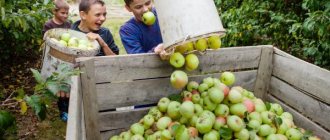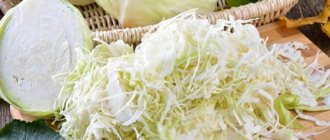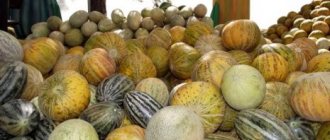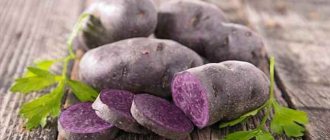What varieties of potatoes to choose for storage
Happy owners of premises for long-term storage of vegetables every fall rush to stock up for the winter. At the same time, every time they think about which potatoes are best stored. During this period, farmers are in a hurry to sell their crops, so the choice of potatoes and their cost are especially pleasing.
What determines keeping quality
Keeping quality - the property of potatoes to persist for a long period without significant weight loss, damage by various diseases, deterioration of marketable, taste and seed qualities.
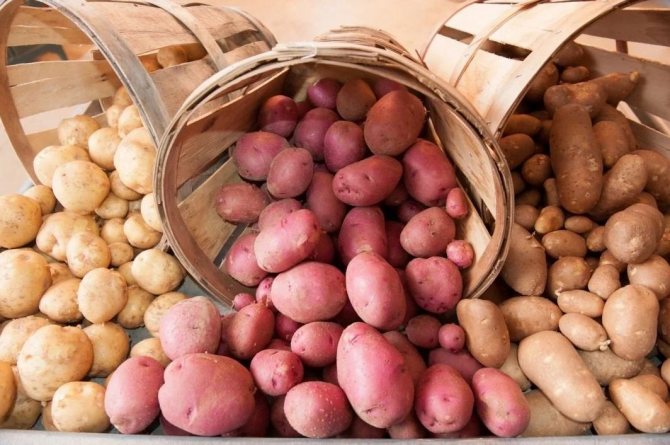
Stocks of potatoes for the winter
NSU All-Russian Research Institute of Potato Farming named after A.G. Lorkha developed a method for predicting the keeping quality of potatoes. Of course, this is primarily necessary for potato producers, but ordinary buyers may well use this technique. It includes the study of external factors such as moisture and the type of soil in which the tuber was grown, the way the tuber was harvested and loaded into storage. There are other characteristics that the consumer cannot see with their own eyes.
But it is possible and even necessary to consider internal factors. These include:
- features of the variety (resistance to late blight and mechanical damage, ripeness, size and weight of potatoes);
- storage method (container, bin, bulk);
- storage conditions (drying potatoes, ventilation of the room);
- characteristic of the tuber (the degree of damage, the incidence of diseases and pests, the level of elasticity).
Before purchasing large quantities of potatoes, it is recommended to use the "bag method" to determine the quality and keeping quality of potatoes. To do this, buy 1 kg of the vegetable you like, and possibly several types, are placed in separate bags, which are tied and stored in a cool place (15-20 ° C) for two weeks. The package creates a microclimate that contributes to the rapid development of diseases, if any.
Attention! If the potatoes in the bag are all or to a greater extent covered with phytophthora, wet rot or other diseases, such potatoes are not suitable for long-term storage.
And if the tubers remain intact, you can safely buy it and be sure that this variety will be stored until the next harvest.
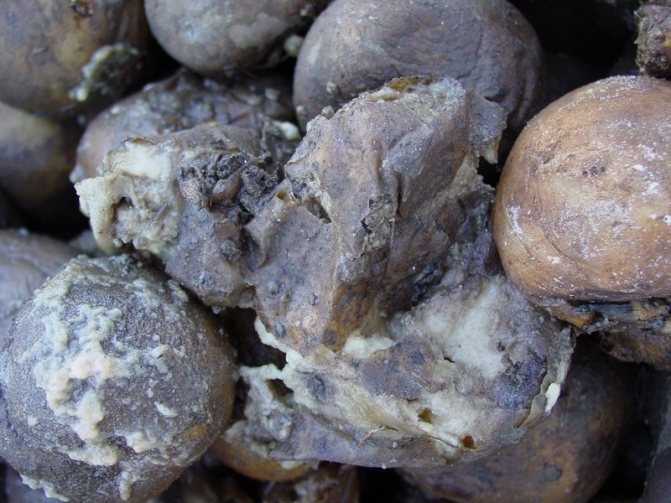

Wet rot can destroy the entire potato supply
Which potatoes last longer, red or white
Its color has absolutely no effect on the shelf life of a vegetable. Among the entire huge number of species, you can choose well-wintering ones with both red and white peels.
The color of the potato affects its other qualities. For example, white potatoes contain more starch, so they boil better and are suitable for mashed potatoes. And pink is more often used for frying and preparing salads.
More antioxidants are found in red potatoes, so it is more often recommended for dietary nutrition. And the content of vitamin A in yellow potatoes is twice as high as in white and red ones.
Attention! It would be correct not to dwell on one variety of potatoes, but to choose several varieties with different tastes for storage.
Cold potatoes are great food for intestinal microflora
Chilled potatoes are resistant fiber, which is essentially resistant starch, that is, starch that our body does not digest and, going through the digestive system, it reaches the large intestine intact and safe. This means that our bacteria will have something to eat.
The beneficial microflora that we need for immunity and overall health comes from probiotics or fermented foods. But once it gets into your large intestine, it will die if there is no food there. And the microflora is a very capricious lady, she needs the correct ratio of bacteria, and the fiber is different. Therefore, colon health is the path to harmony too!
Summing up: potatoes (potatoes) for weight loss are a necessary thing, especially for those who really cannot live without it. Eat small amounts, baked in the oven, boiled in a uniform and chilled in the refrigerator for 24 hours, with butter or vegetable oil in reasonable amounts. And be sure in the presence of a large number of non-starchy vegetables and greens.
Why are medium-late and late varieties recommended for wintering
The ripening time of potatoes is an important indicator when choosing a variety for storage. Potatoes with medium or late ripening times are stored for the longest.
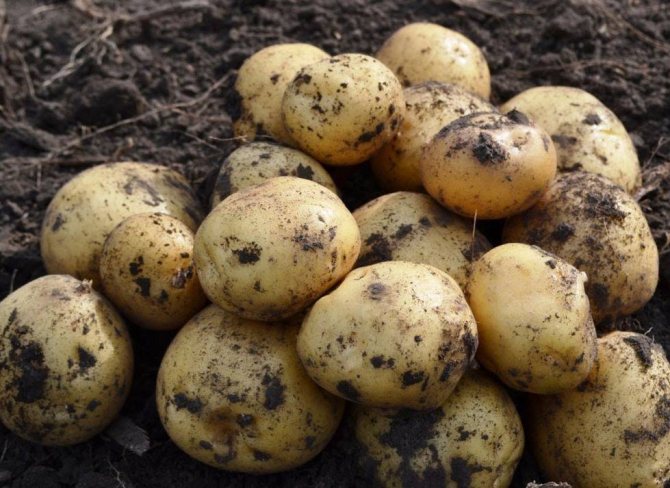

Early varieties have too thin peel, not able to store potatoes for a long time
Early varieties of tubers have very thin skin and tubers quickly become lethargic and lose their flavor. They will lie in the cellar for 1-2 months and even under ideal conditions they will remain at best until November.
For reference! Early varieties can be stored in the cellar if the use of such potatoes is a priority.
Medium varieties, which have a ripening period of up to 100 days, are grown for winter storage, potatoes have a keeping quality and do not germinate until spring.
Culinary tricks
Making mashed potatoes is easy, but there are some nuances here.:
- Overcooked potatoes will only improve the taste of the dish. Hardy tubers are difficult to knead in mashed potatoes, and pieces remain in the finished dish.
- To cook the vegetables better and faster, they are completely peeled and cut into large pieces.
- After the end of cooking, the water is poured into a separate bowl. Little by little, the liquid is added to the puree, making it softer.
- To create a delicious dish, take half the water in which the potatoes were cooked and half the fresh milk.
- Do not add cold water to the product - this will lose the taste and attractive color. It is advisable to boil tubers in an enamel pot - in an aluminum and iron pan, they become grayish.
- Before adding water and milk to mashed potatoes, salt the mashed potatoes. The liquid will dissolve the salt, and when stirred, it will be evenly distributed throughout the mass.
A little water is poured into the pan so that the potatoes are steamed more.
Read also Cells for nutria do it yourself drawings of a photo
The final touch - add a little butter to the even hot puree to give a special taste.
Early potato varieties for long-term storage
Despite the fact that early potatoes are created for a quick harvest and cannot be stored for a long time, there are exceptions.
Red Scarlet (Holland)
The Dutch vegetable, which has taken root on the territory of Russia due to its taste, is one of the early ripening ones. Young potatoes begin to dig in after 45 days, and full ripening occurs after 70-80 days.
Outward signs of Red Scarlet:
- shape - elongated, oval;
- peel color - pink;
- pulp color - light yellow;
- the texture of the peel is velvety;
- eyes are small, shallow, yellow.
Starch content 10-15%.
Important! The higher the starch content, the less the potatoes are boiled, and the taste improves.
When cooking, the vegetable crumbles slightly, but does not boil, while retaining its shape.Not suitable for mashed potatoes, but ideal for French fries, frying, making chips.
The variety is resistant to rot, thanks to which it can be stored well. Long-term winter storage is possible under favorable conditions:
- air temperature +1 .. + 5 ° C;
- complete lack of sunlight;
- insulated room;
- good ventilation from all sides.
Luck (Russia)
The variety is early, ripens at 70-80 days, suitable for consumption and storage in the summer-autumn period.
Tuber characteristics:
- shape - rounded;
- size - large, the mass of one tuber reaches 200-250 grams;
- peel color - light brown;
- the texture of the peel is smooth, thin;
- eyes are small, shallow, sparse;
- the color of the pulp is white; when cooked, it acquires a slight yellowness.
Starch content - 12-14%, during cooking it retains its shape, suitable for salads, frying, stewing, baking.
The average storage time is 5-6 months, while 80-90% of the potatoes are preserved.
Rosara (Germany)
An ultra-early variety that reaches ripeness in 65-70 days.
Description:
- shape - oblong-oval, sometimes drop-shaped;
- size - one-dimensional, weighing up to 110 grams;
- peel color - red-pink;
- the texture of the peel is slightly rough;
- pulp color - light yellow;
- eyes are small, shallow.
The starch content is 12-14%. Rosara is not boiled soft, it is used for preparing first courses, salads, side dishes. Remains firm when frying.
Important! This variety is resistant to late blight and gray rot, is well transported, suitable for long-term storage under favorable conditions.


Rosar's potatoes
Medium potatoes for long-term storage
Medium varieties are suitable for long-term storage, they retain their taste and appearance until spring, practically without losses.
Gala (Germany)
Gala is a medium early variety with good taste and resistance to many diseases.
External characteristics:
- shape - rounded, slightly elongated;
- size - average from 70 to 120 grams;
- the color of the pulp is yellow;
- peel color - bright yellow;
- the texture of the peel is smooth, slightly peeling, strong;
- the eyes are purple, slightly deepened.
Starch content - 14%, does not boil over. The keeping quality of Gala reaches 90%, the tubers are well stored without losing their qualities.
Nevsky (Russia)
People also call Nevsky the blue-eyed. Refers to medium early, with a ripening period of 90 days.
External description:
- shape - rounded;
- size - average 90-130 grams;
- the color of the pulp is white;
- skin color - light beige;
- the texture of the peel is smooth, even;
- eyes - purple, in-depth.
Potatoes contain only 12% starch, which is why they are considered dietary. Suitable for making soups and salads, not suitable for frying and mashed potatoes, since it does not boil at all, the potatoes remain firm.
The keeping quality of the variety is high, 96% of the potatoes are preserved until spring, but then, even at low temperatures, they begin to germinate together.
Important! Before laying it in the cellar, be sure to dry it thoroughly.
Rocco (Holland)
Refers to varieties with an average ripening period of up to 90 days. The palatability is characterized as excellent.
External characteristics:
- shape - oval-rounded;
- size - medium up to 120 grams;
- pulp color - light cream;
- peel color - hot pink;
- the texture of the peel is thin, smooth;
- eyes are rare, shallow.
The benefits of mashed potatoes
- Classic mashed potatoes usually consist of boiled white or yellow potatoes, butter, milk or cream, and salt. A half-glass serving of homemade puree weighs approximately 120 grams and contains 108 calories, which is only 6% of the daily intake on a 2,000 calorie diet.
- This volume contains about 2 grams of protein and 18 grams of carbohydrates, these carbohydrates contain about 2 grams of dietary fiber, which is about 6% of the daily value... On a low-carb diet, subtract fiber to get the exact carbohydrate count. Dietary fiber, in addition to all of the above, supports heart health and helps regulate weight.
- For enveloping properties, easy digestibility and delicate consistency, dietary puree on water is included in diet of sick and children.
- Proven that mashed potatoes can serve an excellent source of carbohydrates for athletes and maintain blood glucose levels during vigorous exercise.
- Puree is a great source of vitamin A A and group vitamins B... A small serving contains 6% of the daily intake of vitamin A. This antioxidant supports eye health, improves immunity and plays an essential role in the functioning of vital organs.
- Vitamins B3 and B6 have the most impressive numbers in comparison with other B vitamins, which puree provides. Their content can reach 8-9% of the daily value.
- Among other functions, B vitamins work together to aid metabolism convert food into energy... In 2020, Nutrients magazine published an article highlighting the importance of all B vitamins for strong nervous system health. As noted by the author of the publication, a lack of B3 or niacin is associated with Parkinson's disease, and low B6 levels can cause dementia.
- Mashed potatoes also provide 6% of the RDI vitamin A K... This nutrient is most commonly found in green leafy vegetables. Vitamin K supports bone health and blood clotting.


Late varieties of potatoes for long-term storage
Late ones are the best potatoes for winter storage. Some species are able to be stored until the next harvest without loss of taste and retaining elasticity. Losses during long-term storage of late potato varieties are minimal. Which potatoes are best stored in winter? Below are two popular varieties.
Picasso (Holland)
A late-ripening Dutch variety that reaches full maturity in 130 days.
External characteristics:
- shape - rounded oval;
- size - large up to 140 grams;
- pulp color - cream;
- peel color - light yellow with pink spots around the eye;
- the texture of the peel is rough, dense;
- eyes - pink, in-depth.
The starch content is 10-12%, does not darken and does not boil over.
Important! Picasso is one of the best varieties for winter storage. It preserves well, does not germinate during storage.
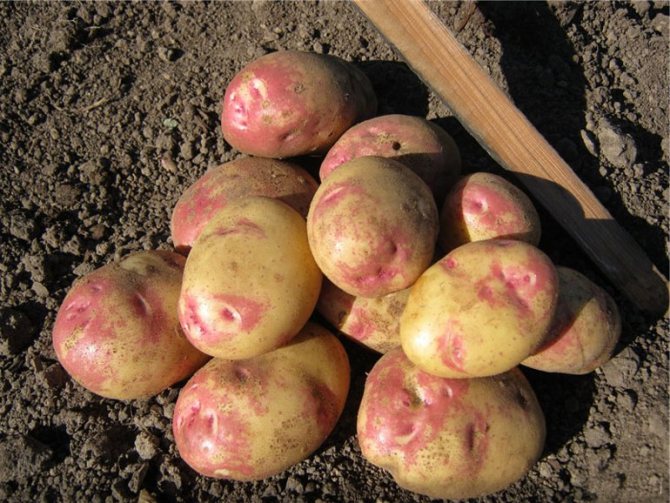

Picasso potatoes
Zhuravinka (Belarus)
Good variety of late ripening, up to 120 days, proven over 20 years.
Description:
- shape - rounded;
- size - average 90-110 grams;
- pulp color - light yellow;
- peel color - hot pink;
- the texture of the peel is rough with a pronounced relief, of medium thickness;
- eyes - small light purple.
Contains up to 20% starch, easy to digest, suitable for making mashed potatoes, soups, potato zraz, and is also used to obtain starch. Keeps well until next summer.
When choosing potatoes for the winter, varieties are good for long-term storage, you should definitely remember about varieties with a late ripening period. You can buy a couple of bags of just such a potato and eat it in the spring.
What determines the taste of the product?
The taste of a dish is influenced by the amount of starch contained in potatoes.
Important! Starch is the main factor to look out for when choosing a product for frying or cooking.
High starch content
It is believed that these types of potatoes are much tastier than others. As a rule, they are used for making purees. Also used for baking and cooking the product in the peel. This is due to the crumbly texture of the potato.
To wash or not wash potatoes before storing
There are four steps to preparing potatoes before storage:
- Culling. Vegetables need to be sorted out, because potatoes with signs of disease, rot or damage will not be stored, they must be consumed first.
- Healing. The potatoes are dried, give time for ripening and tightening of mechanical damage.
- Cooling. Ideally, the storage temperature should be lowered gradually (by 1 degree per day) for better storage.
- Main. During winter dormancy, potatoes must be provided with favorable conditions. The storage place should not receive sunlight, temperature 2-4 degrees, air humidity 85-90%.
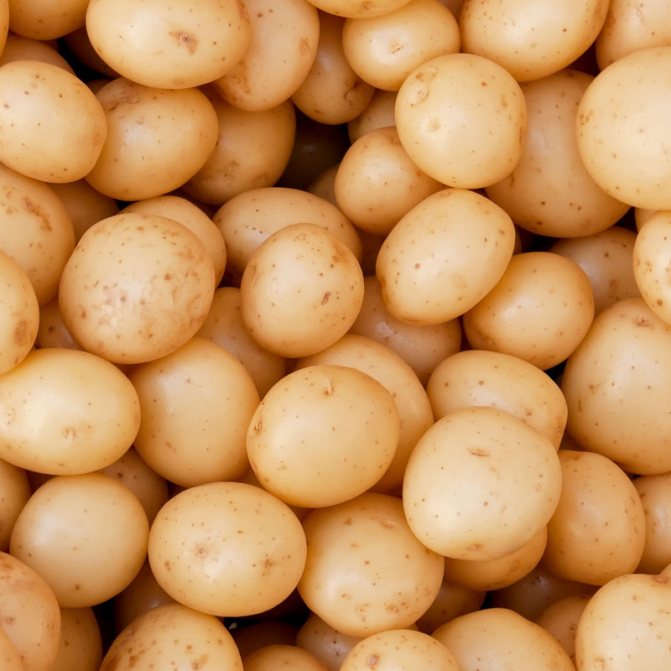

Washed potatoes
Of course, washed potatoes look prettier than unwashed ones and are more convenient to use when processing and preparing dishes, but this process has much more disadvantages:
- a washed vegetable, if not dried properly, is subject to rapid decay;
- in the process of washing, the skin is damaged, which also contributes to rotting;
- the washing process is quite laborious and requires large areas for drying.
Washing the potatoes is recommended if the harvest was carried out in wet weather and it is necessary to remove the layer of dirt. If the harvesting was carried out in dry weather, then it is enough just to dry the tubers.
Growing features
If in the properties one can note some advantages, then this cannot be said about agricultural technology, since purple potatoes are much more whimsical than their colorless "brother" and need special care.
- First, it is more susceptible to scab and has a low degree of resistance to late blight.
- Secondly, the Colorado potato beetle - the scourge of all potato growers - attacks plantings with purple pulp of tubers in the first place (In details:Folk remedies for fighting the Colorado potato beetle)
- Thirdly, if you propagate purple varieties with "eyes", the tubers inevitably and catastrophically become smaller, turning into a wild-growing form.
The work continues. Today, 30% of all existing varieties are involved in the selection process. This will make it possible to quickly remove the purple root crop, not only resistant to pests, but also immune to diseases of the family.
For the rest, the agricultural technology of colored potatoes does not differ from the generally accepted one when growing this vegetable. It does not require special conditions.
- Fertilizers for potatoes when planting
- Weeding and hilling.
- Regular watering throughout the growing season.
- Disease and pest control.
- Productivity depends on the care and composition of the soil. The most unsuitable soil for purple potatoes is loam. And the best ones are fertile and breathable, with a light structure.

